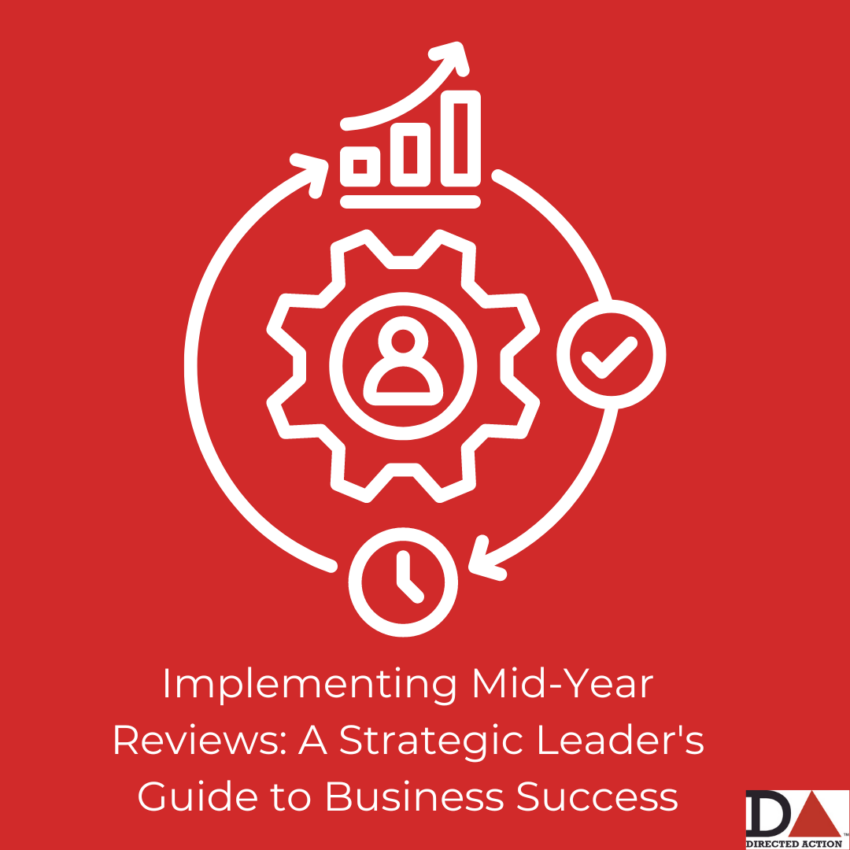Implementing Mid-Year Reviews: A Strategic Leader’s Guide to Business Success
It’s July and we’re halfway through the year. We covered PTO last month and doubtless some of us are contending with relaxed schedules for us and our staff. At these times, when we have the opportunity to do heads down work, perhaps without additional distractions, it’s a great time to consider a mid-year review.
Strategic leaders understand that the success of their organization hinges on continuous assessment and adaptation. Mid-year reviews are an essential tool for these leaders to ensure that their business remains on course, identifying potential issues early, and making necessary adjustments to strategy and operations. Here’s how strategic leaders can effectively implement mid-year reviews to check in on the key aspects of their business.
1. Setting the Stage: Preparing for the Review
Before diving into the mid-year review, it’s crucial for leaders to prepare thoroughly:
- Gather Data: Collect quantitative and qualitative data across various business functions. This includes financial performance, operational metrics, customer feedback, and employee performance reports.
- Define Objectives: Clearly outline what the mid-year review aims to achieve. This could be assessing progress towards strategic goals, identifying areas for improvement, or realigning resources.
- Engage Stakeholders: Ensure that key stakeholders are involved in the review process. This includes department heads, team leaders, and other senior managers who can provide insights into their respective areas.
2. Reviewing Financial Performance
Financial health is the backbone of any business. Strategic leaders should:
- Analyze Financial Statements: Review income statements, balance sheets, and cash flow statements to gauge the financial health of the organization.
- Compare with Projections: Assess the actual financial performance against the projections made at the beginning of the year. Identify any significant variances and understand the reasons behind them.
- Cost Management: Evaluate cost structures and identify areas where expenses can be optimized without compromising on quality or performance.
3. Assessing Operational Efficiency
Operational efficiency directly impacts the bottom line and customer satisfaction. During the mid-year review:
- Evaluate Processes: Analyze key operational processes to identify bottlenecks, inefficiencies, or redundancies.
- Quality Control: Assess the quality control measures in place and their effectiveness. Ensure that the products or services meet the required standards.
- Technology Utilization: Review the use of technology and automation in operations. Identify opportunities for further technological integration to enhance efficiency.
4. Monitoring Market Position and Competitiveness
Understanding the market dynamics and the competitive landscape is crucial for strategic positioning:
- Market Analysis: Conduct a thorough market analysis to understand current trends, customer preferences, and emerging threats.
- Competitive Benchmarking: Compare your business performance with key competitors. Identify strengths and weaknesses relative to the competition.
- Customer Feedback: Gather and analyze customer feedback to understand their needs and satisfaction levels. Use this feedback to make informed decisions about product or service improvements.
5. Evaluating Strategic Initiatives
Strategic leaders must continuously monitor the progress of major initiatives:
- Project Milestones: Review the status of strategic projects and initiatives. Ensure that they are on track to meet the set milestones.
- Resource Allocation: Assess the allocation of resources to various projects. Reallocate resources if necessary to ensure the most critical initiatives receive adequate support.
- Risk Management: Identify any risks that have emerged since the start of the year and develop mitigation strategies.
6. Fostering Organizational Culture and Employee Engagement
A positive organizational culture and engaged employees are essential for long-term success:
- Employee Feedback: Conduct employee surveys or focus groups to gather insights on their engagement, satisfaction, and any concerns they may have.
- Professional Development: Review the effectiveness of training and development programs. Ensure that employees have opportunities for growth and career advancement.
- Work Environment: Assess the overall work environment and organizational culture. Identify areas where improvements can be made to enhance employee morale and productivity.
7. Realigning Goals and Strategies
Based on the findings of the mid-year review, strategic leaders should:
- Adjust Goals: Reassess and, if necessary, adjust the goals set at the beginning of the year to reflect the current business environment.
- Update Strategies: Modify business strategies to address any identified issues or capitalize on new opportunities.
- Communicate Changes: Clearly communicate any changes in goals or strategies to the entire organization. Ensure that everyone understands their role in achieving the revised objectives.
For strategic leaders, mid-year reviews are more than just a routine check-in; they are a critical component of effective business management. By systematically assessing financial performance, operational efficiency, market position, strategic initiatives, and organizational culture, leaders can ensure that their business remains agile and responsive to changing conditions. This proactive approach not only helps in achieving short-term goals but also lays a solid foundation for long-term success.
Implementing a structured and comprehensive mid-year review process allows strategic leaders to steer their organization with confidence, making informed decisions that drive growth and stability. It’s an opportunity to pause, reflect, and recalibrate, ensuring that the business is on the right track to achieve its vision and objectives.
Fostering Employee Engagement
In terms of employees, fostering employee engagement deserves its own deep dive. Mid-year reviews provide an opportunity to do that.
Mid-year reviews often get overshadowed by the more prominent end-of-year performance evaluations. However, these mid-year check-ins are equally, if not more, crucial for personal and organizational success. They serve as a vital checkpoint, allowing both employees and managers to assess progress, recalibrate goals, and ensure alignment with the broader objectives of the organization. Here’s why mid-year reviews are indispensable and how they can significantly contribute to the success of both individuals and organizations.
1. Early Course Correction
One of the primary benefits of a mid-year review is the opportunity for early course correction. Six months into the year is a perfect time to evaluate progress against goals. If an employee or a team is veering off track, this review provides a chance to identify the issues and implement corrective measures promptly. This proactive approach prevents minor issues from escalating into major problems by the end of the year.
2. Enhanced Communication
Mid-year reviews foster open and ongoing communication between employees and managers. Regular check-ins promote a culture of feedback where employees feel valued and heard. This continuous dialogue can help in resolving misunderstandings, clarifying expectations, and strengthening the relationship between employees and their supervisors.
3. Motivation and Engagement
Acknowledging accomplishments and providing constructive feedback during mid-year reviews can significantly boost an employee’s motivation and engagement. Recognizing achievements halfway through the year reaffirms that their efforts are noticed and appreciated, which can enhance their commitment to their work. Additionally, discussing career development and growth opportunities during these reviews can align employee aspirations with organizational goals, leading to higher satisfaction and retention rates.
4. Goal Reassessment and Realignment
The business landscape is dynamic, and goals set at the beginning of the year may need to be reassessed to reflect new priorities or changes in the market. Mid-year reviews provide an opportunity to realign goals and objectives, ensuring that they remain relevant and achievable. This flexibility helps in adapting to unforeseen challenges and capitalizing on new opportunities.
5. Skill Development and Training Needs
During mid-year reviews, managers can identify skill gaps and discuss the necessary training and development needs with their employees. Addressing these gaps promptly ensures that employees have the tools and resources they need to perform effectively in their roles. This focus on continuous learning and development is crucial for maintaining a competitive edge in today’s fast-paced business environment.
6. Performance Documentation
Documenting performance and feedback regularly through mid-year reviews ensures that there is a comprehensive record of an employee’s progress and contributions throughout the year. This documentation can be invaluable during annual reviews, promotions, or when making decisions about bonuses and raises. It provides a balanced and detailed account of an employee’s performance rather than relying solely on end-of-year impressions.
7. Stress Reduction
Waiting until the end of the year to address performance issues or acknowledge achievements can create unnecessary stress for both employees and managers. Mid-year reviews distribute this workload more evenly throughout the year, making the process more manageable and less stressful for everyone involved. Regular reviews ensure that there are no surprises during the annual evaluation, making it a more fair and balanced process.
Conclusion
Mid-year reviews are not just a routine administrative task; they are a strategic tool for driving performance and engagement. By taking the time to assess progress, provide feedback, and realign goals, organizations can foster a culture of continuous improvement and ensure that their teams are on the right track to achieve their objectives. Investing in mid-year reviews is investing in the long-term success and growth of both employees and the organization as a whole.
Embrace the mid-year review as a powerful mechanism to enhance communication, motivation, and performance. It’s a win-win approach that benefits everyone involved and paves the way for a successful second half of the year.



